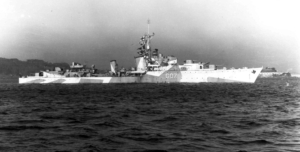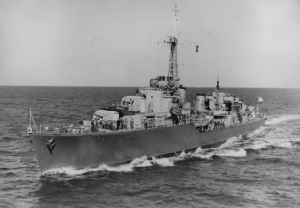OFFICIAL HISTORY OF
Caution: This article contains dated, biased and/or racist language.
One of Canada’s first Tribal destroyers was named ATHABASKAN in honour of the Athabaskans, one of the most widely spread indigenous groups on the continent. They are located in three geographical divisions – the Norther, South Western, and Pacific Coast.
 The keel of the new “Tribal” class destroyer was laid in England in the fall of 1940, and launched by Lady Tweedsmuir on 18 November, 1941. HMCS ATHABASKAN was commissioned into the Royal Canadian Navy on the 3rd February 1943, under the command of Commander G.R. Miles, O.B.E, RCN. ATHABASKAN had a displacement of 1,990 tons, her length was 377’, breadth 37’ 6”, draught 9’ forward and 15’ 2” aft, her main propulsion was geared turbines, endurance of 5,200 nautical miles at 15 knots, and her main armament was six 4.7”guns, two 4” HA/LA, one 2-pounder pom-pom 4 barrel, six turn Oerlikons, four 21 inch torpedo tubes, 2 depth-charge throwers, and one trap (46 depth-charges carried). She had a complement of fifteen officers and 239 ratings.
The keel of the new “Tribal” class destroyer was laid in England in the fall of 1940, and launched by Lady Tweedsmuir on 18 November, 1941. HMCS ATHABASKAN was commissioned into the Royal Canadian Navy on the 3rd February 1943, under the command of Commander G.R. Miles, O.B.E, RCN. ATHABASKAN had a displacement of 1,990 tons, her length was 377’, breadth 37’ 6”, draught 9’ forward and 15’ 2” aft, her main propulsion was geared turbines, endurance of 5,200 nautical miles at 15 knots, and her main armament was six 4.7”guns, two 4” HA/LA, one 2-pounder pom-pom 4 barrel, six turn Oerlikons, four 21 inch torpedo tubes, 2 depth-charge throwers, and one trap (46 depth-charges carried). She had a complement of fifteen officers and 239 ratings.
After “working-up” at Scapa Flow, she went on operational duty with the Royal Navy. Late in August, 1943, while senior ship of a group operating in the Bay of Biscay, ATHABASKAN was damaged by a German aerial glider bomb dropped from one of five aircraft. The bomb passed through the ship under the bridge and exploded 25 feet beyond. One boiler room and two oil fuel tanks were flooded; however, she managed to return to port at a speed of 12 knots.
In December, 1943, ATHABASKAN being again fully operational returned to the Home Fleet and in far Northern waters played her part in the engagement which resulted in the sinking of Germany’s proud ship the Scharnhorst.
In February, 1944, ATHABASKAN with HURON and HAIDA joined the 10th Destroyer Flotilla based at Plymouth and took part in night sweeps in the channel and Bay of Biscay against German destroyers, trawlers, E-boats, and coastal shipping. During an offensive sweep in the English Channel early in the morning of 29th April, ATHABASKAN and HAIDA encountered enemy destroyers of the Elbing Class. Repeated hits were obtained and one of the enemy destroyers was driven ashore and left on fire. During the course of the action, ATHABASKAN was torpedoed and sunk. Although HAIDA stopped to pick up survivors, she was warned to get clear by Lieutenant Commander J.H. Stubbs, Commanding Officer of ATHABASKAN who by that order left himself and many of his men on drifting rafts to meet a cold unfriendly dawn off an enemy coast rather than risk losing another ship.
The Commanding Officer together with 10 officers and 100 men were lost in the sinking, five Officers and 80 men were picked up by the enemy and taken prisoner, while one Officer and 45 men were picked up by HAIDA and landed in England.
Within three weeks of the sinking, a new destroyer was laid down in Halifax and in August, 1944, she was named the ATHABASKAN. A badge which had been designed by officers of the original ship, but not completed before she was lost in action, was retained as a special tribute to those gallant officers and men who went down with their ship. In heraldic terms, a description of the badge is: Blazon: on a field of Argent, a North American Indian, clad in buckskin breeches, leggings and beaded moccasins, but bare to the waist except for a necklace of bear’s claws and Blue shells, and ear ornaments of the last. The Indian wears the full-feathered head-dress and is mounted bare-back upon an Indian pony being halted from position, the latter pointed down.
The ship’s colours are Red and White and her proud motto “We fight as one”. She was given the Hull Number CN-391.
On the 11 May, 1946, ATHABASKAN was launched at Halifax. ATHABASKAN was commissioned on the 20th January, 1948. On the 19th of May, she sailed for the west coast. En route, she did work-ups, drills, and exercises, arriving in Esquimalt on 19 June. Off the Oregon coast, polio struck the ship. One Petty Officer contracted the disease and before the ship could reach land he died. After reaching Esquimalt on the 29 June 1948, ATHABASKAN was quarantine until the 12 July. Seven more men were moved to the hospital and the ship was fumigated. Afterwards, ATHABASKAN was ready to join the other ships and form the second Canadian Destroyer Division.
 Between 10 October 1948 and 15 September 1949, she participated in cruises, visiting foreign ports, and work-up exercises en route. She then went into refit, emerging at the end of March, 1950, to once again commence work-ups.
Between 10 October 1948 and 15 September 1949, she participated in cruises, visiting foreign ports, and work-up exercises en route. She then went into refit, emerging at the end of March, 1950, to once again commence work-ups.
Her armament consisted of eight four-inch guns as well and Bofors and Oerlikons for close range gunnery. She was fitted with four twenty-one-inch torpedo tubes and carried depth-charges as well.
At the commencement of the war in Korea, ATHABASKAN was ordered to join the UN Forces, so on 5 July 1950, she started her long 7,185 mile voyage. From then until 1953, she participated in patrols of the waters, anti-submarine protection, escorted ships, and assisted in capturing ports, transporting troops, evacuation, and bombardments. She returned to Canada twice during this time period for refits. On 26 July 1953, when the Armistice was signed, she made her final return voyage from Korea to Canada, arriving in December, 1953.
In 1954, ATHABASKAN paid off into dockyard hands for a long refit and modernization, and was commissioned on 25 October 1954. She commenced “work-up” exercises and during cruises carried out intensive manoeuvering and drills. She continued until 1959 when it was decided she should join the Atlantic Command on the east coast. She sailed on 19 January and arrived in Halifax on 16 February. After two weeks of transferring stores and personnel, she commenced exercises.
To those who have sailed on her, whether the first or second of name, are proud of her. To those who follow, the Battle Honours – Arctic, 1943-44; English Channel, 1944; Korea, 1950-53 – are an inspiration to add even more renown to the illustrious name – ATHABASKAN.

 CFB Esquimalt Naval and Military Museum
CFB Esquimalt Naval and Military Museum
 CFB Esquimalt Naval and Military Museum
CFB Esquimalt Naval and Military Museum CFB Esquimalt Naval and Military Museum
CFB Esquimalt Naval and Military Museum CFB Esquimalt Naval and Military Museum
CFB Esquimalt Naval and Military Museum CFB Esquimalt Naval and Military Museum
CFB Esquimalt Naval and Military Museum CFB Esquimalt Naval and Military Museum
CFB Esquimalt Naval and Military Museum CFB Esquimalt Naval and Military Museum
CFB Esquimalt Naval and Military Museum CFB Esquimalt Naval and Military Museum
CFB Esquimalt Naval and Military Museum CFB Esquimalt Naval and Military Museum
CFB Esquimalt Naval and Military Museum CFB Esquimalt Naval and Military Museum
CFB Esquimalt Naval and Military Museum CFB Esquimalt Naval and Military Museum
CFB Esquimalt Naval and Military Museum CFB Esquimalt Naval and Military Museum
CFB Esquimalt Naval and Military Museum
 CFB Esquimalt Naval and Military Museum
CFB Esquimalt Naval and Military Museum CFB Esquimalt Naval and Military Museum
CFB Esquimalt Naval and Military Museum CFB Esquimalt Naval and Military Museum
CFB Esquimalt Naval and Military Museum CFB Esquimalt Naval and Military Museum
CFB Esquimalt Naval and Military Museum CFB Esquimalt Naval and Military Museum
CFB Esquimalt Naval and Military Museum CFB Esquimalt Naval and Military Museum
CFB Esquimalt Naval and Military Museum CFB Esquimalt Naval and Military Museum
CFB Esquimalt Naval and Military Museum CFB Esquimalt Naval and Military Museum
CFB Esquimalt Naval and Military Museum CFB Esquimalt Naval and Military Museum
CFB Esquimalt Naval and Military Museum CFB Esquimalt Naval and Military Museum
CFB Esquimalt Naval and Military Museum

 CFB Esquimalt Naval and Military Museum
CFB Esquimalt Naval and Military Museum CFB Esquimalt Naval and Military Museum
CFB Esquimalt Naval and Military Museum CFB Esquimalt Naval and Military Museum
CFB Esquimalt Naval and Military Museum CFB Esquimalt Naval and Military Museum
CFB Esquimalt Naval and Military Museum CFB Esquimalt Naval and Military Museum
CFB Esquimalt Naval and Military Museum
 CFB Esquimalt Naval and Military Museum
CFB Esquimalt Naval and Military Museum



 CFB Esquimalt Naval and Military Museum
CFB Esquimalt Naval and Military Museum



































 CFB Esquimalt Naval and Military Museum
CFB Esquimalt Naval and Military Museum CFB Esquimalt Naval and Military Museum
CFB Esquimalt Naval and Military Museum
 CFB Esquimalt Naval and Military Museum
CFB Esquimalt Naval and Military Museum